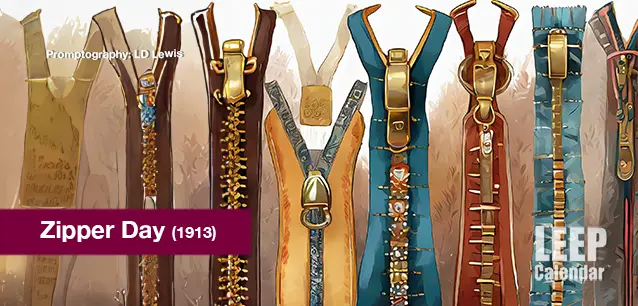 AD
AD
Today is: November 13
Scroll to explore events active on this date.
Additional Events on LEEP
LEEP INK FEATURES

August? Absolutely!
In August, we live through the Dog Days of Summer. It's hot and often humid, and those who can leave for better climates do. Down south, winter is in full force. August is also known as "the ...

In The Heat of July: July 2025 Events
Is it hot enough (or cold enough if you're below the equator) for you yet? There is actually a day for that! Like every month, I pick a diverse collection of events you may or may not know about. This ...

May Blooms: Events in May 2025
Along with October, May is one of the most densely packed months of the year. It's before the summer humidity and the last whole month of the school year. The weather is warming in t...
About National Zipper Day
Retail , United States
Ends: Apr 29, 2024
DESCRIPTION:
ABOUT ZIPPER DAY
On April 29, 1913, Gideon Sunbach received a patent for his zipper invention. It was not an immediate success. Rather, his new technology would take 20 years to find its fans and become ubiquitous in the apparel industry. THE LONG ROAD TO ZIP
The zipper's origin story unfolds in the late 19th century, when Elias Howe, renowned for his sewing machine invention, was awarded the first patent for a fastening device resembling a zipper in 1851. Despite not pursuing the development of his 'Automatic, Continuous Clothing Closure,' Howe's contribution laid the foundation for the zipper.
In 1893, Whitcomb L. Judson, an inventor from Chicago, presented a more refined version of the concept at the World's Columbian Exposition. Judson's 'Clasp Locker,' a fastener for shoes and boots, operated on a hook-and-eye principle, marking a significant step forward in zipper evolution. Judson's invention, though modestly received, set the stage for the zipper's transformation.
The actual leap forward came with the involvement of Gideon Sundback, a Swedish-American electrical engineer. Sundback's improvements to Judson's design were revolutionary. He increased the number of fastening elements from four per inch to about ten or eleven and introduced two facing rows of teeth that were pulled into a single piece by a slider. By December 1913, Sundback had perfected the 'Separable Fastener,' the ancestor of today's zipper. His invention received a patent in 1917. Sundback also created the machine necessary to manufacture the new device, solidifying his place in zipper history.
Despite these advancements, the zipper only caught on after a while. Its initial application was limited to boots and tobacco pouches, and for many years, it remained a novelty rather than a necessity. The fashion industry, in particular, was slow to adopt the zipper, relying instead on buttons and hooks that were seen as more traditional and aesthetically pleasing.WHY WASN'T THE ZIPPER INITIALLY ACCEPTED?
The zipper's slow acceptance can be attributed to several factors, each presenting a unique challenge:
These challenges, however, did not deter the zipper's evolution.
TIRES AND ZIPPERS
The turning point for the zipper came in the late 1920s and early 1930s, nearly two decades after Sundback's patent—the B.F. Goodrich Company noted for its tires, began using zippers in its rubber boots. The company coined the term "zipper" in 1923 because of the sound it made when closing and opening. The practicality and ease of use offered by zippers gradually won over skeptics, and their adoption in children's clothing for its simplicity showcased its potential to the wider apparel industry.
One pivotal moment in the zipper's history was its inclusion in men's trousers, particularly with the introduction of the "Battle of the Fly" in the 1930s. Fashion designers and manufacturers began to see the zipper's potential for creating sleeker, more streamlined garments. By the time World War II began, the zipper had become an essential component of military uniforms, further cementing its place in everyday wear.
CONCLUSION
The history of the zipper is a testament to the challenges of introducing new technologies into traditional industries. Its journey from an overlooked patent to an indispensable part of daily life underscores the interplay between innovation, industry resistance, and the gradual shift in societal norms and practices. The zipper's slow path to acceptance highlights the importance of perseverance and the need for inventions to be technically sound and meet the practical and aesthetic needs of their time.
VIDEOS
Currently, this event does not have supporting videos.
SUPPORTING DOCUMENTS
Currently, this event does not have supporting documents.
ADDITIONAL IMAGES
Currently, this event does not have supporting images.
Where would you like to go now?
 AD
AD


/footer-logo.svg)
